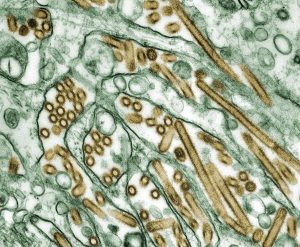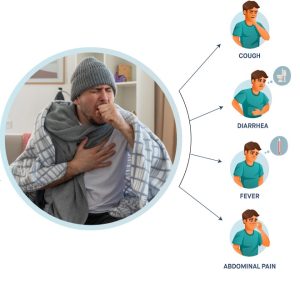viral fever
Bird Flu Avian Influenza virus of type A of subtype H5N1

A H5N1 also known as Influenza A virus subtype H5N1, is a subtype of the influenza A virus which is able to cause illness in many other animal species and especially in birds and notifiable in humans and A bird-adapted strain of H5N1, Highly Pathogenic Avian Influenza virus of type A of subtype H5N1 commonly called as HPAI A(H5N1) for , is the highly pathogenic cause of H5N1 flu, commonly known as avian influenza (“bird flu“). It is maintained in the population (enzootic) in many bird populations, especially in Southeast Asia. One strain of HPAI A (H5N1) is spreading globally after first appearing in Asia. It is an epidemic in nonhumans (epizootic) and affecting animals of many species (panzootic), especially over a wide area, killing tens of millions of birds and spurring the culling of hundreds of millions of others to stem its spread. The WHO and United Nations Food and Agriculture Organization, H5N1 spread is gradually increasing in endemic areas, but the avian influenza disease situation in farmed birds is being held in check by vaccination, and so far there is “no any proof of sustained human-to-human transmission” of the virus. Eleven outbreaks of H5N1 were reported worldwide in June 2008 in five countries (China, Egypt, Indonesia, Pakistan and Vietnam) compared to 65 outbreaks in June 2006 and 55 in June 2007. The global HPAI situation significantly improved in the first half of 2008, but the FAO reports that imperfect disease surveillance systems mean that occurrence of the virus remains underestimated and underreported. In July 2013 the WHO announced a total of 630 confirmed human cases which resulted in the deaths of 375 people since 2003.
Several H5N1 vaccines have been developed and approved, and stockpiled by a number of countries, including the National Stockpile of U.S.A, England, Paris, Canada, and Melbourne, to use in an emergency.

Research has shown that a highly contagious strain of H5N1, one that might allow airborne transmission between mammals, can be reached in only a few mutations, raising concerns about a pandemic and bioterrorism.
An avian disease HPAI A(H5N1) although there is some evidence of limited human-to-human transmission of the virus. A risk factor for contracting the virus is handling of infected poultry, but transmission of the virus from infected birds to humans has been characterized as inefficient. Still, around 60% of humans known to have been infected with the current Asian strain of HPAI A(H5N1) have died from it.H5N1 may mutate or reassert into a strain capable of efficient human-to-human transmission. Due to the high lethality and virulence of HPAI A(H5N1), its endemic presence, its increasingly large host reservoir, and its significant ongoing mutations, the H5N1 virus has recently been regarded to be the world’s largest current pandemic threat, and billions of dollars are being spent researching H5N1 and preparing for a potential influenza pandemic. Several companies and governments are developing prepandemic influenza vaccines in 28 different clinical trials that, if successful, could turn a deadly pandemic infection into a non-deadly one.
H5N1 may cause more than one influenza pandemic, as it is expected to continue mutating in birds regardless of whether humans develop herd immunity to a future pandemic strain. Influenza pandemics from its genetic offspring may include influenza A virus subtypes other than H5N1.While genetic analysis of the H5N1 virus shows that influenza pandemics from its genetic offspring can easily be far more lethal than the Spanish flu pandemic, planning for a future influenza pandemic is based on what can be done and there is no higher Pandemic Severity Index level than a Category 5 pandemic which, roughly speaking, is any pandemic as bad as the Spanish flu or worse; and for which all intervention measures are to be used.
medlight2u.com
Acne Acne vulgaris Acute Renal Failure Adrenal cortex Angina Angina Pectoris Aortic Regurgitation (AR) Aortic Stenosis (AS) Chest pain Chronic pyelonephritis Coarctation of Aorta Cough cyanosis Cystic acne Dehydration depression Diabetes Mellitus Diagnosis of Aortic Stenosis Dr.KTS DR K TAMILSELVAN Fatigue Heart Failure Hypertension Hypokalemia Hypothyroidism Ischemic Heart Disease LBBB Mitral Incompetence Mitral insufficiency Mitral valve prolapse Nocturia Patent Ductus Arteriosus PDA Polyuria Proteinuria pulmonary hypertension Pulmonary Stenosis ST Depression Symptoms of Acne Syncope Treatment for acne valvular heart disease Ventricular Septal Defect VSD Zits

Leave a Reply